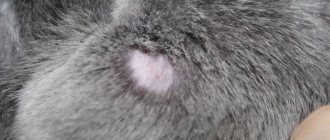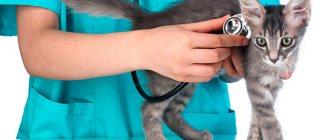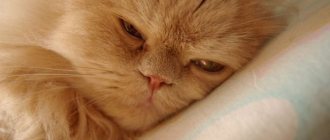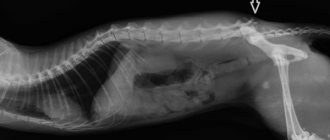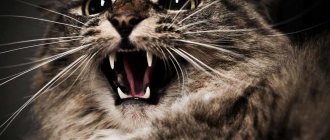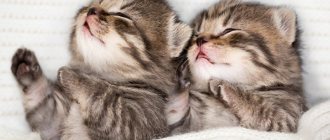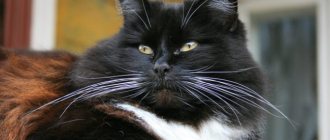Hind limb failure in a cat is a symptom that can indicate many different diseases. Often, an accurate diagnosis can only be made by a veterinarian after examination and testing. In some cases, the animal’s limbs can be restored to function if treatment is started in time.
Let's look at the reasons why a cat's hind legs may fail, how to provide first aid, basic treatment methods and possible prognoses.
Symptoms of pathology
Most often, limb paralysis does not occur immediately. First, signs of motor dysfunction appear, which is why the pet does not immediately lose control of its legs, but gradually. Veterinarians recommend not to hesitate to contact the clinic
if the following symptoms appear:
- The cat begins to hesitantly step on the pads. Before he steps, he tries to find his balance.
- Dragging appears when the cat is unable to move its paws: it drags them without lifting them off the floor. It seems that the pet is sneaking up on the prey during the hunt. The next stage will be paralysis of the lower or lateral part of the body.
- The cat's limbs move greatly when walking or standing.
- Constant back squatting. This often occurs in older individuals over 10 years of age.
- Severe swelling in the pelvic cavity due to bites from dogs or other cats, trauma, problems with internal organs or the lower part of the spine.
- General loss of mobility even in a young animal. The cat prefers the opportunity to lie down and relax to games.
The appearance of one or more symptoms becomes a reason to contact a veterinary hospital. Delay in consultation may result in paralysis of part of the body.
The only non-dangerous situation is a wobbling gait in small kittens. This is a natural reason, it is explained by the weakness of muscle tissue at a young age. This goes away over time and does not require therapy.
Why does the cat stand on its hind legs?
Contents hide
Why does the cat stand on its hind legs?
Users of social networks and happy owners of cats with enviable regularity post cute and unusual videos for everyone to see, the heroes of which are pets standing on their hind legs. Sometimes people say that in an upright position their pets resemble meerkats: the English-speaking segment of the Internet provides thousands of links with answers to the request: “why cat sits like a meerkat.” Indeed, why does this happen, since the natural state of a cat is to be on all fours?
1. The cat scares away the enemy. From the outside, such behavior may seem funny, but in this situation the little predator takes itself more seriously than ever. If a pet feels that it is being threatened by someone or something larger than itself, the best way out seems to be to “become more powerful,” at least visually, that is, to rise on its hind legs. The animal uses the most important survival tactics. A domestic cat can react in this way to a vacuum cleaner, hair dryer and other types of equipment that inspire fear in it. Therefore, you should not laugh at your pet, even if it looks comical. It would be more correct to protect it from the source of stress so that it is less likely to be seen by the animal.
2. The cat asks for something tasty. Our pets are cunning ones. They perfectly read human emotions, notice when we are angry or happy. It is likely that they also understand the tenderness of the owner when he looks at his pet, standing on its hind legs and with a prayer in its eyes. How can you refuse a treat when you see this picture, because the cat seems to be trying so hard for you? A resourceful cat owner can take advantage of the situation: this way you can teach your pet a simple trick, but, of course, do not deceive the animal. If the cat has done what was required of it, it deserves a tasty gift.
3. The cat is hunting. In fact, this reason is the most obvious. Many pets stand on their hind legs when watching birds at the window or simply playing with their favorite toys. While we puzzle over what this could mean, our cats are guided by a very simple motive: to be seen better.
4. Behavior is dictated by the structural features of the body. Munchkins, for example, have a different center of gravity from cats of other breeds due to their short limbs. They can stand upright and maintain excellent balance. But Scottish Folds are the owners of a mutated cartilage gene that is unable to support the weight of the ear in a standing position. It is important that the gene affects not only the ears. Cartilage is closely related to bones and joints. This is responsible for some of the features of lop cats, in particular, flexibility, fragility of the front legs (many Scots are very protective of their paws and do not even allow them to be touched) and the ability to hold their body “in a standing position” a little longer than other cats.
5. Animals with disabilities sometimes adapt not only to stand, but also to walk on their hind legs due to the absence of forelimbs. In some cases, this can also happen due to a genetic mutation, meaning the cat was already born without front legs. In 2015, a kitten (Roux) moving on its hind legs gained fame on social networks. Ru has adapted perfectly to life on two legs, and she is helped in this by a wonderful person with a kind heart - an employee of a cat shelter who took a special pet home.
Photo source: www.unsplash.com
Causes of immobilization
There are quite a few reasons why a cat’s hind legs fail, and almost all of them entail serious consequences, including paralysis and death. It is almost impossible for the owner himself to understand what happened to his pet. Only a veterinarian is able to make the correct diagnosis, prescribe adequate treatment and prescribe appropriate medications. Therefore, if a cat loses its paws, it is extremely unwise to delay visiting a specialist.
Spinal injury
Fractures, fissures, and other injuries to the spine or spinal cord are the most common cause of paralysis or paresis (muscle relaxation) of the lower torso. A cat can be injured in different ways: from a strong blow, falling under the wheels of a car, as a result of a fight, or falling from a great height.
The symptoms accompanying the injury depend entirely on its severity and location. Painful sensations arise from contact with a damaged surface. Sometimes the feet become cold to the touch, and there is uncontrollable bowel movements and urination.
Spinal shock occurs during spinal injury. This condition is characterized by rapid breathing, strong heartbeat, low body temperature, and severe fainting.
Spinal injuries are not always immediately visible. Symptoms may appear a couple of weeks or even months after the injury. Modern methods of therapy help restore your pet’s health completely and make his life comfortable and happy.
The main thing when detecting damage is to place the victim on a hard, flat surface and urgently take him to a veterinary clinic.
Limb injury
Problems with the hind legs occur due to fractures, severe bruises, sprains, cuts to the pads or injuries to the nails. If the cat reacts painfully to touching the tips of its paws, carefully examine them.
Usually the animal tucks in its damaged paw and moves on three healthy limbs, which does not seem to be a harbinger of paralysis. But if both legs are damaged, it is quite possible to mistake the pet’s condition for paresis or immobilization.
Hernia on the intervertebral disc
Immobilization of the hind legs can be caused by compression of the nerves in the back due to the growth of a hernia. It is formed on the intervertebral cartilaginous disc, which holds the vertebrae together. Thanks to the discs, shock absorption and mobility of the spinal column as a whole are ensured.
Fortunately, this disease is rare in cats. It is diagnosed mainly in aging individuals. The disease does not always provoke complete paralysis - in most cases, the animal’s legs become weakened, the patient’s gait changes greatly, but he retains the ability to move independently.
Spinal inflammation
Another pathology of the hind limbs is inflammation affecting the spinal cord. The process is triggered by various types of infections: viral, parasitic or bacterial. Often these are complex autoimmune diseases, severe poisoning, and pathologies characteristic of pregnant females. The condition is accompanied by weakness, pain, fever, incontinence, and disruption of the gastrointestinal tract. Death in some cases can occur very quickly, especially if emergency treatment is not started.
Arterial or fibrocartilaginous embolism
Embolism is a situation when a blood clot completely or partially blocks a vessel. Arterial thromboembolism is not considered an independent pathology - it is caused by cardiovascular and pulmonary diseases, atherosclerosis.
As a result of the blockage of the vessel, blood flow slows down, and tissues and organs experience oxygen starvation, which causes the accumulation of metabolic products. When a blood clot appears, severe pain, swelling, and pallor of the pads occur. Problems with movement appear as limping or dragging of the feet. The affected limb feels very cold. Necrosis of tissues and organs begins if the blood supply is not quickly restored.
Fibrous-cartilaginous embolism is a blockage of the vessels of the spinal cord. In most cases, complete paralysis of the entire body quickly occurs; in advanced cases, treatment can be long and difficult.
Avitaminosis
A severe lack of vitamins leads to metabolic and developmental disorders. Often severe vitamin deficiency occurs in kittens, young or pregnant individuals. Lack of vitamin B1 causes weakness and failure of the hind legs. In addition, vitamin deficiency leads to general lethargy, apathy, fever, and rare urination.
The main causes of vitamin deficiency: poor nutrition, infections, parasites inside the body. Long-term use of antibiotics is also bad for your cat's health.
Hip dysplasia
The development of excess connective tissue makes the joint too mobile. Congenital dysplasia can be noticed already in the first months of a kitten’s life. The risk group includes purebred Maine Coons, Persians, Siamese, exotics, British, Scottish, and Norwegian forest cats.
In addition to genetic predisposition, there are other causes of dysplasia:
- severe obesity;
- disruptions in the hormonal system;
- injuries;
- lack of calcium.
Symptoms of hip dysplasia include lameness, unsteady gait, and fear of stepping on the affected leg. A slight crunching sound can be heard as the animal moves. The cat often spends time lying down with its limbs stretched out to the sides. He doesn't tuck his paws under himself like he did before.
Nutritional hyperparathyroidism
Excessive production of the hormone parathyroidin, which is responsible for phosphorus-calcium metabolism, causes this disease. It is characterized by the release of calcium from the bones into the blood of the animal. The result is thinning and destruction of the bone structure, which subsequently leads to deformation of the limbs. The pet experiences severe pain and begins to limp. Neurological illness damages the vertebrae and provokes limb failure.
Nutritional hyperparathyroidism is associated with malfunctions of the parathyroid gland due to an imbalance of vitamins and minerals. This can be caused by poor nutrition, prolonged feeding of one type of natural food, or cheap food.
Infection from a tick bite
An encephalitis tick can bite a pet while walking in the fresh air. 2-3 days after the bite, the animal develops weakness, high fever, lack of appetite, and serous discharge from the nose and eyes. Sometimes the cat gets sick.
Further damage to the brain and central nervous system causes fainting, severe seizures and paralysis. Death occurs in half of infections. Only timely measures will help prevent irreversible consequences.
Stroke
A stroke causes blockages from blood clots and bleeding in the brain. When individual areas are affected, complete or partial immobilization occurs. The temperature in the extremities drops due to poor circulation, and swelling appears. Low activity of a neutered cat can be considered one of the factors in the development of stroke.
Arthrosis and arthritis
Arthrosis is the destruction of cartilage of a non-inflammatory nature; it is caused by injury or metabolic disorders. Excessive physical activity that is not appropriate for the age or health of the animal also leads to problems with cartilage tissue. The pet experiences severe pain when moving, and joint deformation begins.
Arthritis is an inflammation of the cartilage that is most often hereditary. Other causes include infections, injuries, autoimmune ailments, and metabolic disorders. The pet gets tired quickly and moves unsteadily.
Tumors
Neoplasms in the spine or spinal cord are destructive to the musculoskeletal system, causing complete immobilization of the paws. All tumors are dangerous, but the most destructive are glioma, osteosarcoma, lymphosarcoma, and meningioma. In most cases, treatment requires surgery.
Cardiomyopathy
The pathology is associated with problems in the functioning of the heart: the myocardium (the muscular part of the organ) ceases to function normally for a number of reasons. Cardiomyopathy can be detected using ECG and MRI. Most often, a decrease in physical activity and drug therapy are prescribed to relieve stress on the heart.
Kidney failure
This is a disease that affects cats of all ages. The disease leads to severe neurological disorders, and brain functions also suffer. In case of untimely treatment, partial paralysis of the lower part of the animal’s body develops.
Incorrectly placed injection
Illiterate actions of the owner or veterinarian when performing an intramuscular injection damage the sciatic nerve. As a result, the mustachioed friend begins to limp and drag his leg. This especially often occurs after the administration of No-shpa or other antispasmodics. Immobilization lasts 2-3 days and goes away without any treatment.
Any owner should understand that a cat’s paws can only be taken away as a result of a complex disease. It is only a symptom that can be eliminated by treating the underlying cause. Therefore, the most important thing is to contact a specialist immediately.
Causes of hind limb failure
Neurological disorders often lead to failure of a cat's hind legs. In most cases, only a doctor can determine the exact cause of paralysis.
Let's list a number of diseases that can lead to failure of a cat's hind limbs.
Injuries
Although cats are considered graceful creatures, they often fall from roofs or trees. An unsuccessful landing can lead to spinal injury or broken paws. Cats also sometimes get hit by cars. A dog bite or a directed blow can cause mechanical damage to the limbs and spine.
An injured animal may be in a state of shock, so immediately after the incident it will try to hide. When a limb is broken, the animal may feel severe pain when leaning on the limb. The paws may be unnaturally curved. The cat may have a dislocation, open or closed by a redissection.
Thromboembolism
This is a very dangerous disease that can lead to the death of the animal. This is when a cat's femoral artery is blocked by a blood clot (this could be a blood clot, a parasite, or air).
As a result, the limbs are deprived of oxygen supply. Tissue necrosis begins. The animal's condition is rapidly deteriorating.
In the first hours, the following symptoms can be observed:
- anxiety;
- meowing in pain;
- the animal does not allow you to touch the sore area (scratches, bites).
Gradually, the paws completely fail, they become cold. Apathy begins. The cat doesn't eat or drink. Death usually occurs within 2-3 days. You can save an animal if you consult a doctor in the first hours after an artery is blocked by a blood clot.
Dysplasia
This disease most often occurs in large cats (Maine Coons), but smaller breeds are also genetically predisposed to it: Siamese, Persian, Norwegian forest cat, British, Scottish.
You might be interested in: The cat's paw pads are peeling: what could it be?
In most cases, this disease is congenital. It becomes most noticeable during the period of active growth of the kitten. With dysplasia, excessive formation of connective tissue occurs, the joint becomes too mobile. The animal experiences pain while moving.
Main symptoms:
- unsure gait;
- decreased activity;
- when resting, the cat stretches its paws rather than tucking them under itself;
- when walking, the animal experiences pain, and therefore tries not to strain its limbs too much;
- after the jump, the cat falls on its side and meows pitifully.
This disease is incurable. Maintenance therapy should be carried out - anti-inflammatory and painkillers should be given. Obesity should not be allowed in a sick animal, because it increases the load on sore joints.
Kidney failure
A dangerous disease that can appear in cats of all ages. It leads to disruption of the genitourinary system, as well as to a neurophysiological disorder. The functioning of the brain is disrupted.
Main symptoms:
- gradual decrease in the amount of urine;
- indigestion;
- unsteady gait, limb failure;
- increase in body temperature.
Avitaminosis
A poor diet, infection with parasites, and improper care lead to vitamin deficiency. An insufficient amount of vitamins and minerals enters the animal’s body, which causes a disruption in the development of bone and cartilage tissue.
If the animal does not receive enough sunlight, this can lead to rickets, which is often found in kittens. When it occurs, the development of bone tissue is disrupted, the limbs become bent and become fragile.
Lack of potassium leads to paresis of the limbs.
To avoid vitamin deficiency, the animal needs to be provided with a proper, complete diet. A cat that eats natural food should additionally receive vitamins.
Among ready-made food, preference should be given to premium and super-premium class. Economy class food does not contain enough minerals and vitamins.
Cardiomyopathy
Cardiomyopathy leads to an increase in the volume of the walls of the heart muscle, due to which the volume of the ventricles decreases. The heart pumps less blood. Oxygen starvation begins. The animal's limbs go numb.
Main symptoms:
- decreased activity;
- unsteady gait;
- refusal to eat;
- vomit.
Cardiomyopathy itself cannot lead to complete paralysis of the hind limbs. But because of it, thrombosis of the femoral artery can occur.
Stroke
There is a blockage of one of the blood vessels in the brain. A stroke can lead to paralysis of not only the limbs, but also all muscles. The animal may be completely immobilized.
Main symptoms:
- breathing and swallowing problems;
- severe anxiety;
- complete apathy;
- loss of sensation in the limbs;
- vomit.
Stroke is a very dangerous disease that can often lead to the death of an animal. A sick cat needs urgent medical attention. The sooner the correct diagnosis is made and measures are taken, the greater the chance of survival and recovery of the animal.
Spinal injury
The spine may be damaged due to injury or internal pathological processes.
The main sign of spinal injury is paralysis of not only the paws, but also the tail.
The animal begins to walk under itself. The sensitivity of the limbs is completely lost.
When a spinal fracture occurs, the following symptoms may occur:
- the cat's tail hung
- rapid breathing;
- loss of consciousness;
- strong heartbeat;
- decrease in body temperature.
Intervertebral hernia
A hernia forms on an intervertebral disc. An experienced doctor can detect it by palpation. The nerves are compressed, causing the animal to be unable to move its limbs normally.
You might be interested in: Why does a cat shed a lot?
Most often, a hernia occurs in older animals. In most cases, it does not lead to complete failure of the limbs, but only to a disturbance in gait. The situation can only be corrected by surgical intervention.
Tick paralysis
The bite of ixodid ticks leads to the entry of toxic substances into the body. The disease develops very quickly.
At first, the cat begins to behave very excitedly. Afterwards, activity decreases and limbs fail. The cat stops eating and drinking and reacts poorly to stimuli. Body temperature rises greatly. Severe trembling and vomiting are possible. The animal loses consciousness and convulsions begin.
The cat can be saved only if treatment is started in time. In half of the cases when bitten by an infected tick, the animal dies.
Spinal cord inflammation
It can occur for various reasons: infection by parasites, poisoning, infection and others.
Main symptoms:
- increased body temperature;
- indigestion;
- urinary incontinence.
With timely consultation with a doctor, complete restoration of limb function is possible.
Hyperparathyroidism
Most often, hyperparathyroidism is caused by improper and unbalanced feeding of the animal. The production of hormones is disrupted. Calcium from the animal's bones enters the blood. The bones themselves become thinner and more fragile. The animal's gait is disturbed, the cat feels severe pain. The spine also becomes more fragile. Neurological functions are impaired, causing the cat's hind legs to fail.
Nerve damage during injection
Sometimes when administering an intramuscular injection, the owner or doctor may hit the sciatic nerve with a needle. This can lead to temporary impairment of the animal's paw. Often the limb returns to normal within a few days.
First aid at home
Before you take the victim to the veterinary clinic, you need to take a few simple steps:
- Calm the animal. If paw failure occurs suddenly, the cat will inevitably experience stress - it needs to be relieved with kind words and the creation of a quiet atmosphere around.
- Check the temperature of the paws - if they are cold, place a heating pad or a bottle of hot water under them. It is better to wrap it in a towel - this way the animal will not get burned.
- If you are sure that the cause is not injury, place your pet in a soft-covered carrier.
- For injuries to the paws or spine, on the contrary, a hard and flat surface is needed. If possible, you need to immobilize the cat - but so that he does not get nervous. Perhaps on the way to the clinic it is enough to hold him on top with your hands.
- With viral or bacterial infections, the animal may vomit and diarrhea is possible. In such cases, it is necessary to lay the cat on its side so that it does not choke, and put a disposable diaper on it.
When going to the veterinary clinic, do not panic. Take a syringe without a needle with water (if the animal wants to drink), a veterinary passport, a change of clean diaper, and wet wipes. If it's cold outside, take care of a light but warm blanket.
Diagnosis and treatment of illness
In a veterinary clinic, a doctor examines a patient: palpates muscles and joints, determines sensitivity to touch, and checks reflexes. Then X-ray examinations are prescribed - the image can show the presence of fractures, dislocations, neoplasms (tumors), and joint deformities.
One type of radiography is myelography. The procedure is performed to examine the spine using contrast fluid. The test helps determine the presence of a spinal cord tumor or herniated disc. Computer or magnetic resonance imaging (CT or MRI) is considered more detailed, but also more expensive.
If the veterinarian suspects infection, inflammatory processes, or metabolic disorders, he will prescribe blood and urine tests, as well as bacterial cultures.
Once the diagnosis is made, treatment begins. It depends entirely on the disease, the symptom of which is paw failure.
Conservative methods
For diseases of the joints and cartilage, anti-inflammatory and painkillers and therapeutic physiotherapy are prescribed. Blood clots are eliminated with anticoagulants and fibrinolytic medications, but if they do not work immediately, surgery is performed.
Hip dysplasia is treated with analgesics, chondroprotectors or physiotherapy. In severe cases, surgery will have to be performed.
A course of antibiotics and supportive medications are prescribed for inflammation of the spinal cord. Vitamin deficiency and nutritional hyperparathyroidism are eliminated by adjusting the diet and using vitamin-mineral complexes. The diet is prescribed by a veterinarian, who also monitors the patient until complete recovery.
You can cope with the consequences of an encephalitis tick bite with a course of antibiotics, diuretics (diuretics), nootropic and anticonvulsants. They try to restore the affected areas of the brain with the help of neurotransmitters, antispasmodics, and restorative medications.
All medications must be used strictly in accordance with the instructions prescribed by the veterinarian! Any deviation from the prescription is fraught with complication of the condition of the mustachioed patient.
When is surgery indicated?
Basically, spinal injuries are treated with surgery, the same is suitable for removing hernias - this reduces the load on the intervertebral discs. In rare cases, conservative treatment is required. Limb injuries require surgery only in case of severe displacement or spread of fragments.
If the cause of immobility is tumors of various types, then radiation, medications and surgical intervention can help the animal.
Thromboembolism requires a quick response. If medications do not help within 6-8 hours after the blockage of the vessel, veterinarians perform surgery to remove the blood clot.
Physiotherapy
For some animals, paw mobility does not return or partially returns even after the root cause of paralysis is eliminated. Then the owner needs to apply physiotherapeutic methods - this will restore sensitivity to the paws and tone to the muscles.
Physiotherapy can be carried out in parallel with drug therapy, but first you need to coordinate this with a veterinarian so as not to harm the pet and not cause discomfort, pain, or stress.
What exercises are good:
- stroking and tickling paw pads - from 2 to 6 times a day;
- “bicycle” - carefully reproduce the pedaling of the cat’s paws;
- imitation of walking - for this, a ball or a wide strip of fabric (towel) is placed under the cat’s belly, by which the person holds the pet; The cat must thus remember the walking mechanism and try to repeat it.
Physiotherapy may also include a special massage that your veterinarian will demonstrate to you. The key to this type of treatment is patience, as results may take several weeks or even months to appear.
Causes
It is possible to independently determine the reason why a cat walks poorly only in the event of an injury that occurred in front of the owner. In other cases, only a qualified veterinarian, based on a survey and examination, is able to correctly guess the primary diagnosis.
The diseases that cause such difficulties can be completely different. Some cause partial paralysis of the hind legs, while others can cause complete paralysis of the hind legs.
Parasitic infections
Often, a cat begins to walk poorly after ear mites have lived in the ears for a long time. Its presence causes the appearance of pus in the inner ear, and if the body cannot overcome this phenomenon on its own, it leads to inflammation of the membranes of the brain. Even more serious consequences can be caused by internal parasites that spread through the bloodstream and settle in the tissues of the brain or nervous system.
Thromboembolism of arteries
Occurs due to the migration of a blood clot and blockage of a blood vessel. This causes ischemia and tissue death. The occurrence of blood clots is provoked by pathologies such as hypertrophic or dilated cardiomyopathy.
Thromboembolism always has a pronounced onset: the cat screams or meows loudly, suddenly begins to walk poorly. When trying to palpate the tissues in the pelvic area, she may behave aggressively due to pain. The paws often become cold because the blood supply is impaired. You can pay attention to the condition of the pads: they become lighter than on healthy paws. The animal's overall body temperature may decrease. Often the pet breathes heavily with its mouth open.
In such cases, you need to react very quickly, since if you do not intervene, death will soon occur.
Intervertebral hernia
When the intervertebral disc is displaced, increased pressure on the spinal cord is observed. Due to deterioration of the innervation of the hind limbs, the animal begins to walk poorly. This can range from minor incoordination to complete paralysis, depending on the stage of pressure. Old animals and overweight cats are more susceptible to intervertebral hernias, but such a picture can develop after an injury.
The problem often affects breeds with short tails, as they have anatomical changes in the sacral part of the spine. Most often, their symptoms progress gradually, and if they are identified at the initial stage and the correct treatment is prescribed, the problem can be eliminated or its progression can be stopped.
Myelitis
A very dangerous disease in which a cat can behave aggressively even towards family members. Sometimes there is a high temperature, the hind legs become entangled, and serious digestive problems arise. There are urinary disorders. A sick animal tends to constantly lick its hind paws or bites them intensely.
The cause of myelitis can be infection, severe poisoning, or complications after pregnancy. In simpler cases, myelitis affects a small area of the spinal cord, but sometimes spreads to all its parts. Then the clinical picture is most severe.
Avitaminosis
With an acute lack of essential vitamins, disruptions in various physiological functions occur. This can be triggered by parasitic infections of the gastrointestinal tract, pregnancy, feeding, and malnutrition (especially at a young age). Vitamin deficiency often develops due to a lack of sunlight, so cats kept in apartments suffer from it more often than animals living in private estates. Sometimes it is triggered by long-term illnesses or taking heavy antibiotics.
Symptoms of vitamin deficiency include increased sleepiness of the pet, weight loss, and anemia. The animal refuses to play and tries to hide in a secluded place. In addition, the condition of the coat deteriorates.
Kidney failure
The symptoms develop rapidly, and the entire genitourinary system quickly fails. Most often, kidney failure can be determined by a decrease in the volume of urine, which becomes less every day. In addition to the fact that the pet begins to walk poorly, it develops lethargy, digestive disorders in the form of vomiting or diarrhea, and the temperature often rises. The condition is deteriorating quickly.
Dysplasia
If the hip joint develops incorrectly, the risk of dislocation or fracture in the upper girdle of the hind limbs increases. At the same time, there is a decrease in motor activity, it is clear that it is painful for the animal to step and walk, lameness of the hind legs appears, and possible curvature of the limbs. The cat prefers to sit in one place, and after an injury it may stop walking and start crawling.
Consequences and forecasts
If you go to the veterinary clinic in time, the percentage of a positive outcome will be very high. Regardless of what caused the paralysis or paresis, quick, qualified help will get your pet back on its feet – literally. If you start the disease, the consequences will be disastrous.
Troubles with the spine will result in complete or partial paralysis of the body, inability to move or even control the processes of bowel and bladder emptying. Such animals need constant care and increased attention. Recovery will be long and not always 100%, but we must not despair.
Viruses and bacterial infections of an aggressive form can kill an animal in a few days. Some diseases (for example, rabies) cannot be treated at all.
Problems with the functioning of internal organs and the endocrine system are quite treatable, but the pet automatically falls into the group of vulnerable animals. Many of them need a lifelong diet and regular medical supervision.
Arthritis, arthrosis and dysplasia cause severe pain to the cat. They cannot be cured, but the process of cartilage destruction can be significantly slowed down. The owner needs to regularly treat his pet and take him to the veterinarian more often. During exacerbations, the cat may stop walking and experience severe pain.
Sad consequences can only be prevented by timely treatment, or better yet, prevention.
How to prevent problems with the musculoskeletal system
Unfortunately, it is impossible to protect yourself from all diseases - even the best owner’s cat can get sick. However, it is possible to minimize the risk - there are simple truths for this:
- Balanced diet
- the key to health. Food or natural nutrition is formulated according to the age, size, activity and breed of the cat. If you don’t know how to do this, consult your veterinarian or breeder.
- Vaccinations
– a reliable barrier against deadly viruses and infections. Even those animals that have never walked outside in their lives need annual vaccination.
- Deworming
– another mandatory procedure for everyone without exception. Cats and dogs need to be wormed once a quarter.
- Preventive examination by a veterinarian
. Like a person, an animal must undergo periodic medical examinations. Cats that are not at risk only need to be examined by a veterinarian before their annual vaccination. “Chronicles”, elderly, weakened individuals need additional tests.
- Activity
– excellent prevention against all diseases. Play with the animal or get him an active friend. Even in old age, a cat must be mobile and flexible - otherwise health problems cannot be avoided.
The most common causes of paw failure in cats include: spinal injuries, thromboembolism, spinal cord injuries, tick bites, hip dysplasia, herniated discs, and nutritional hyperparathyroidism. There are other causes of immobility. Only a veterinarian in a clinic can determine the disease and prescribe adequate therapy - the owner is able to provide first aid, and nothing more.
The article is for informational purposes only. Contact your veterinarian!

